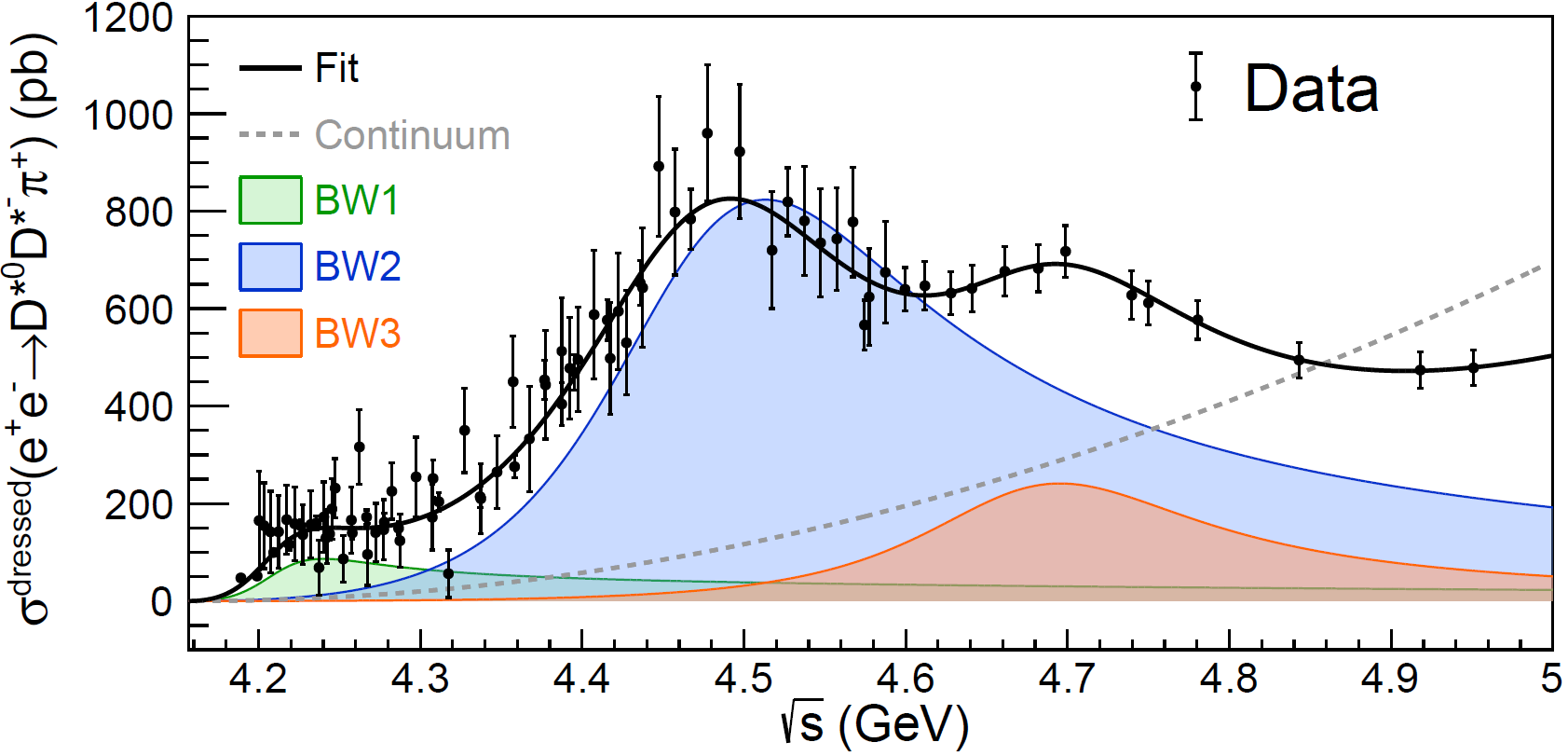The BESIII collaboration recently reported “observations of three vector charmonium-like states with JPC=1-- decaying into D*0D*-π+ produced in e+e- annihilations in the energy range from 4.19 GeV to 4.95 GeV”. The masses of the three resonance states are found to be around 4.21 GeV, 4.47 GeV and 4.68 GeV, respectively, with broad widths larger than 50 MeV. They are candidates of exotic hadrons beyond conventional meson, as no c-cbar charmonium states predicted in quark model are consistent with these new findings. The results have been published in Physical Review Letters on March 23th, 2023. [Phys. Rev. Lett. 130, 121901 (2023)].
Studies of exotic hadrons beyond two-quark meson and three-quark baryon are important topics in hadron physics and of great significance for testing the non-perturbation QCD theory and understanding the color-confinement mechanism. The charmonium spectrum refer to the energy-eigenstates of mesons consisting of a pair of c-cbar constituent quarks. Despite theoretical predictions based on the quark model, experimental observations have revealed a number of unexpected hadron states in this spectrum that are overpopulated relative to what was predicted. In particular, a series of unexpected charmonium-like vector meson ψ states (also denoted as Y) have been reported via electron-positron annihilation, such as ψ(4230), ψ(4360) and ψ(4660). Their genuine properties are still unknown and there exists various theoretical interpretations, including tetra-quarks, hybrid mesons, hadron molecules, hadro-charmonium, vector charmonia and threshold effects. Because all the vector charmonium-like states produced in e+e- annihilation are discovered in the hidden-charm final states, except the ψ(4230), further experimental studies on the open-charm process become of great importance to pin down their nature.

In this study, the production cross sections of the open-charm process e+e--→D*0D*-π+ are measured for the first time, based on 86 data samples corresponding to an integrated luminosity of 17.9 fb-1 collected at center-of-mass energies from 4.19 GeV to 4.95 GeV collected at BESIII. A partial reconstruction technique is employed to identify the D*0D*-π+ final states, in order to improve the detection efficiency. In the energy-dependent cross section distributions, three enhancements around 4.21 GeV, 4.47 GeV and 4.68 GeV are visible. Hence, a simultaneous fit of a lineshape summing over three Breit-Wigner resonances to the cross sections is carried out. Their masses and widths are determined to be
m1=4209.6±4.7±5.9 MeV/c2 , Γ1=81.6±17.8±9.0 MeV;
m2=4469.1±26.2±3.6 MeV/c2 , Γ2=246.3±36.7±9.4 MeV;
m3=4675.3±29.5±3.5 MeV/c2 , Γ3=218.3±72.9±9.3 MeV.
The first and third resonances are consistent with the ψ(4230) and ψ(4660) states, respectively, while the second one is compatible with the ψ(4500) observed in e+e-→K+ K- J/ψ at BESIII. As they are directly produced in e+e- annihilations, their spin-parities can be identified as JPC=1--.
These three ψ states are observed for the first time in e+e-→D*0D*-π+. In particular, the ψ(4500) and ψ(4660) are firstly observed in open-charm decay mode. Given the first resonance is same with the ψ(4230), we find the electronic partial width of the ψ(4230) is larger than the hybrid interpretation under the lattice QCD calculation.
Despite the significant progress made in the observation and identification of these states, it remains challenging to determine their exact internal structures, from a variety of different exotic and conventional meson scenarios. Further amplitude analyses of different open- and hidden-charm final states are desired to advance our knowledge of the nature of these charmonium-like states.
Further reading:


